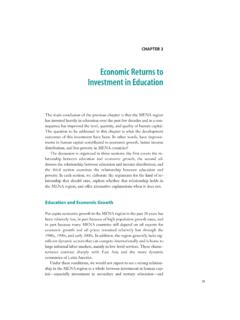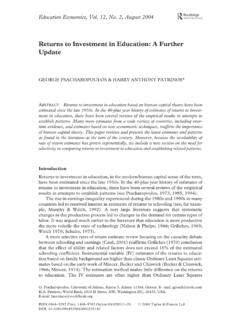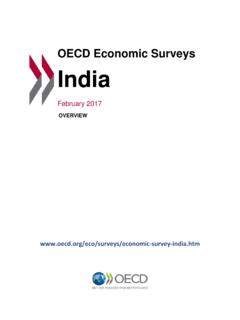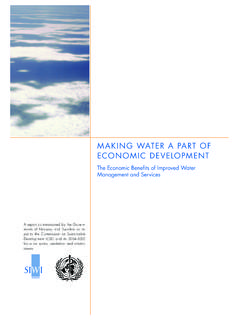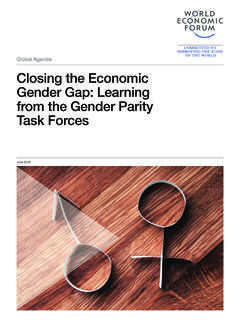Transcription of Education and Economic Growth
1 Education and Economic GrowthPhilip Stevens and Martin Weale National Institute of Economic and Social Research,2, Dean Trench Street,London SW1P 3 HEAugust 2003 Contents1 Introduction12 History13 Returns to Education54 Growth Accounting: the Basic Framework75 Educated Labour as a Factor of Production96 Education and Endogenous Growth127 TheLevelandtheGrowthRate148 WhatsortofEducation?189 DataConcerns1910 Panel Modelling2011 Education and Inefficiency2212 Conclusions25 Support from the Economic and Social Research Council is gratefully paper provides a survey of work on the link between Education and Economic shows that data from the early 20th century are coherent with conclusions about educationand Economic Growth derived from the much more recent past. It also presents an analysis ofthe role of Education in facilitating the use of best-practice is to be published in theInternational Handbook on the Economics of Educationeditedby G and J.
2 Johnes and published by Edward IntroductionThere are two very basic reasons for expecting tofind some link between Education andeconomic Growth . First of all at the most general level it is intuitively plausible thatliving standards have risen so much over the last millennium and in particular since 1800because of Education . Progress of the sort enjoyed in Europe was not observed in theilliterate societies that have gradually merged into the world economy over the last twohundred years. To the most casual observer it must seem that there is a link betweenscientificadvanceandthewayinwhich educationhasfacilitatedthedevelopmentofk nowledge. Of course the Curies and the Newtons of this world are few and far people with only very limited Education oftenfind it difficult to function at all inadvanced societies. Education is needed for people to benefit from scientificadvanceaswell as to contribute to , at a more specific level, a wide range of econometric studies indicates thatthe incomes individuals can command depend on their level of Education .
3 If people witheducation earn more than those without, shouldn t the same be true of countries? Ifnot the rate of change of output per hour worked, at least the level of output per hourworked in a country, ought to depend on the educational attainment of the spending on Education delivers returns of some sort, in much the same way as spend-ing onfixed capital, then it is sensible to talk of investing in human capital, as thecounterparttoinvestinginfixed capital. The process of Education can be analysed asan investment Education has been available since ancient times. In England there is a fairly largenumber of schools which can trace their origins back to the days of Queen Elizabeth1(although rather few much older than the reign of King Edward VI). Nevertheless, theexpansion of Education is largely something which has happened in the last 200 years.
4 Inthe United Kingdom elementary Education did not become compulsory until 1870. Verylimited free secondary Education was introduced in 1907 and it was not until 1944 thatuniversal free secondary Education was introduced. Only a small minority benefited fromtertiary Education until almost the end of the twentieth century. Unlike with primaryand secondary Education there is, however, a lively debate about what level of access (1981) points out that in 1850 very few people outside North-WesternEurope and North America had any formal Education . Even in 1940 that was still truein Africa and in much of Asia and Latin America. The spread of formal school seems tohave preceded the beginning of modern Economic Growth . It is also true that, in somecountries, there have been sudden increases in schooling which are not followed by surgesin Economic development.
5 Furthermore Easterlin suggests some evidence that the typeof schooling is very important. Education in Spain was tightly controlled by the Churchand focused on oral instruction in religion and a few manual skills. Illiteracy remainedrife despite the level of school attendance. He argues that it was the combination ofeducation and protestant Christianity which was responsible for the Economic successof countries in North-Western Europe and their offshoots, at a time when there waslittle Economic development elsewhere. The link between secular Education and theReformation can be deduced from the observation above that few schools in the UnitedKingdom predate 1 shows the expansion of primary Education measured as the enrolment rateper 10000 population drawn from data provided by Easterlin. As an indicator of ed-ucational attainment this measure is obviously unsatisfactory, but historical data arelimited.
6 The lead of the North European countries is obvious, and they held this leadthroughout the 19th to a link between Education and Economic performance, again over this historicperiod there are severe data limitations. However infigure 2 we plot GDPper capitain1913 fromfigures provided by Maddison (1991) against the primary school enrolmentrates of 18821. Whatever concerns one might have about drawing inferences from aplot of seven points, the picture is very clear, that high levels of GDPper capitaareassociated with high levels of primary school enrolment some thirty years earlier. The2020040060080010001200140016001800183 018501882189019001910per 10000 populationUKFranceGermanyItaly SpainBrazilJapanKoreaFigure 1: Primary School Enrolment Rates30500100015002000250030003500400045 00020040060080010001200140016001800 Primary School Enrolment Rate (per 10000 population) in 1882 GDP per Capita (1985US$) in 1913 KoreaBrazilItalyJapanSpainUnited KingdomFranceGermanyFigure 2: Education and GDPper capitaUK appears to be something of an outlier, with an income level higher than its schoolenrolment might lead one to expect.
7 Since both levels of Education and levels of GDPper capitain any particular year are closely related to those in earlier and later years,any conclusions drawn from the graph do not, of course, answer the question whetherthe high level of GDP in France, Germany and the UK is a consequence or a cause of thehigh level of Education . The need to resolve this question of causation in a satisfactorymanner has been one of the major problems faced by studies linking Education andeconomic any deductions from the graph can hardly be regarded as conclusive, it isnevertheless possible, byfitting a regression line, to analyse them in a manner whichallows for some sort of comparability with laterfindings. The result of such an analysisyields the following result (with standard errors in parenthesis):4lnGDP per capita= lnEnrolment Rate+ ( )( )R2= (1)Thus this suggests that a 1% increase in the enrolment rate raises GDP by , to put it in perspective, suppose that an increase in the enrolment rate of 20 %raises the average number of years of Education of the labour force from 5 to 6.
8 Thisis an increase of log units which raises GDP by ; the equation is logarithmicand only approximately linear in percentages. For a less-well educated population anincrease from 2 to 3 years achieved by an increase in the enrolment rate of 50% log units would raise GDP by The equation has to be regarded very muchas a reduced form. Countries with high GDP and high levels of Education also havehigh capital stocks; thus this regression attributes to Education effects which, in a fullyspecified model, would be attributed to the capital stock. Nevertheless, we preserve theresults for future Returns to EducationAny analysis of the determination of Economic Growth has to have some connectionwith the micro- Economic underpinning mentioned above. Because Education deliverseconomic benefits to individuals, we should expect to see effects of Education on group-ings of individuals (nations).
9 We therefore by providing only a brief survey of accountsof the effects of Education on classic study was provided by Mincer (1974). He looked at individual earnings asa function of years of Education and also other factors such as age and experience. Hefound that for white males not working on farms, an extra year of Education raised theearnings of an individual by about 7%. However earnings appeared to be an increasinglinear and decreasing quadratic function of years of work. When allowance was made forthis, the return to a year s schooling increased to The introduction of a quadraticeffect in schooling and a cross-product term between Education and experience suggesteda more complicated pattern of returns but pointed to the early stages of Education beingmore valuable than the later stages. Thefigures of 7% or obviously overstates thereturn to society from investing in extra Education for an individual.
10 It ignores the costof providing the Education , the loss of earnings resulting from time spent being educated5and the fact that the benefits of Education may decay with age and certainly disappearonce an individual retires from the labour force. Secondly, the analysis might be takento infer that everyone is homogenous. The benefits of extra Education are obviouslydifferent for different individuals. People can be supposed tofinish their Education atthe point at which the anticipated return of extra Education to them is just balancedby the extra costs. Given this assumption thefigure measures the average return peryear of Education up to the point at which the marginal return to Education just equalsthe marginal benefitidentified by the individual. With the reasonable assumption ofdeclining marginal effects of Education , it follows that thisfigure must be higher thanthe incremental benefit of an extra year s (1994) provides an international survey of rates of return to Thefigures cover seventy-eight countries.

